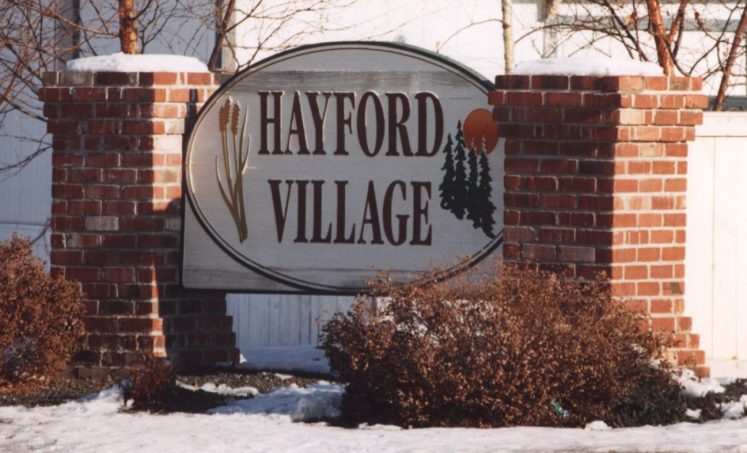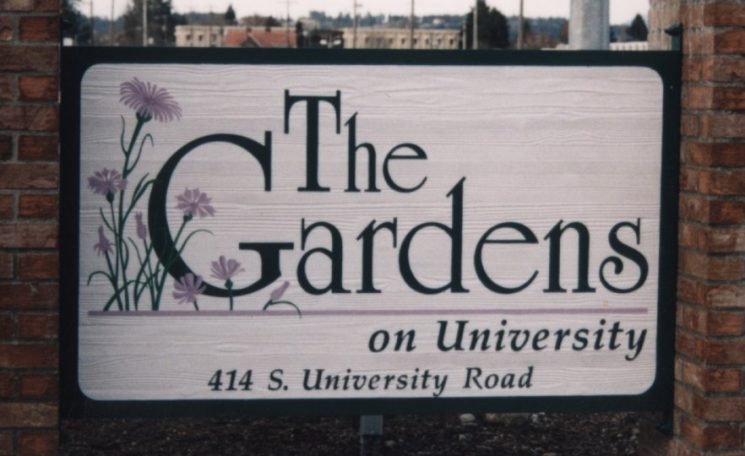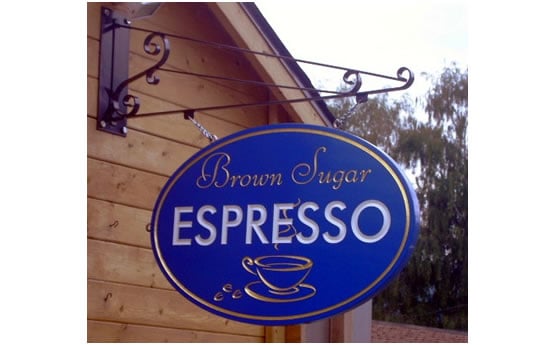For Sale Sandblasted and Carved Wood Signs in HDU, Urethane, Extira, Cedar, and Redwood Online
Custom Carved and Sandblasted Wood Signs are the Grand Daddy of all signs. First there were cavemen, then cave stores, then to beat the competition the more innovative cavemen installed sandblasted hdu signs or wooden letters on their cave stores.
While we’re not precisely sure we can verify this story, we do know that these signage have been around for a long time and are still one of the classiest signs available.
Now though, we are able to offer, in addition to Redwood and Cedar, high-density urethane (HDU) outdoor signs that look and feel like wood, but hold paint better, are more dimensionally stable, and are much lower maintenance than wood.
We can either CNC carve or route your sign or sandblast it …we can even create a wood grain look in the HDU!
Product Uses and Applications
Sandblasted, Carved, Cedar, Redwood or HDU Signs can be used for:
-
- Business Outdoor or Indoor Signs

- Mall Signage
- Professional Office Signs
- Government Building Signs
- Law Offices
- Corporate Headquarters
- Monument Signs
- Development Signs
- Resort Signs
- Golf Course Signs
- For Campers
- Name Signs
- House Signs
- Beach house signs
- Custom CNC wood signs
- …and more!
Product Features and Offering

- Wholesale for bulk order
- 3d hdu signs
- Personalized wood designs
- High density foam monument signs
- Rustic hand carved wood signs
- Rustic cedar signs
- Engraved outdoor wood signs
- … and more!
For carved wood and sandblasted hdu sign pricing, scroll down and fill-up the Quote Form below.
Testimonial
I wanted to take a moment to say ‘Thank you’ for a job well done. Your company did an outstanding job. We absolutely love the signs for our community. I want to personally thank you for making my whole experience with this assignment a very smooth one. You exuberate excellent customer service in every sense of the phrase. It was a pleasure working with you. Again, thank you for the beautiful signs.
– Cassandra, Maryland
Sandblasted and Carved Signs Warranty
Sandblasted and Carved Signs come with a 5-year warranty on all finishes and materials. These signs will be free from physical defects in materials or workmanship under normal use at the original installation site.

Get a Quote Now!
Visigraph is a wholesale domestic and import broker, and therefore, we require a minimum order of $500USD for ALL wholesale orders.
All fields marked with star (*) are required.
Large Quantity Quotations
If you need large quantities of signs, call us at 509-483-8000, email our sales department directly at sales@visigraph.com, or fill out our Get A Quote form.
The Visigraph 100% Satisfaction Guarantee
As a wood sign manufacturer, we pay careful attention to every detail on every order we receive, and our 100% Satisfaction Guarantee is just what it says…you’ll love our custom carved and sandblasted wood signs or we’ll re-do them. It doesn’t happen often, but hey, we’re human too! Rest assured, though, that if it does, we’ll fix’em free of charge and with no hassle.
Calculating the Size of your Carved Wood, Cedar, Redwood, Sandblasted HDU Signs
Length x Width = Number of Square Inches. For example, if you have a decal that is 3” x 5” simply multiply 3 x 5 = 15 square inches.

Carved Wood Signs
Wood is one of the last types of natural, porous materials being used. With synthetics making a very plausible substitute material for most products, it is nice to know that they are still being widely used as signs.
They are routed then sanded and finished; they bring to my mind happy moments of playing with wooden toys and rocking horses during childhood. The feel of a wooden toy is a soothing one, like sand through the fingers. The feel is a comforting one, and the visual impact of wood is also a mentally soothing one.
They are also durable. By using a moisture-resistant finish, natural humidity can be blocked out and they will be in good shape for years to come. This is one of the benefits of wood. They are qualitative and classy, AND they are protected from the rain, snow and mist of early morning dew.
As time goes on, they retain their dignity and class. They may be varnished for a deep shine or they may be painted in bright clear colors, like painted blocks that children use in primary school. Their unmistakable attraction is hard to deny.
The quality of carved wood signage is indisputable. It has been documented as one of the oldest types of informative written communication, historically situated alongside writing in the sand, etchings on cave walls and ancient papyrus scrolls. Of course, not all things stay the same, and sign carving techniques have definitely improved over the years. Centuries later, they remain as popular and impressive as always.
With the global availability of wood and carving tools, wood signs have always done the job for relatively small expense and effort. Depending on taste preferences, one can be geometrically shaped or fancifully carved with curves and swirls. They can be sanded and lacquered or colorfully painted with artistic motifs and golden or raised letters.
Sandblasting Signs
In about 1870, Benjamin C. Tilghman invented and patented a method that used high-pressured air to powerfully drive an abrasive substance against wood or other surfaces to remove paint, moss, dirt, or, in the case of sandblasting, wood particles. It was not long before an enterprising producer figured out that this process could, with a “blast mask,” be adapted to sandblast displays.
In approximately 1932, Wheelabrator patented a new method using the centrifugal force of a wheel to impel abrasives against a target, such as a signage. This method is typically known today as “airless” sandblasting. This system of uses recyclable steel or grit particles to blast the item at hand. These machines vary in size, depending on the type of work the company performs. The larger machines aren’t typically necessary.
Types of Wood in Making a Signage
The most popular woods are redwood and western red cedar, both of which have become increasingly expensive due to the finite supply of redwood in particular. These are both beautiful softwoods that are at their most attractive when their natural beauty is allowed to show through. One other option is a non-wood substitute called High Density Urethane or HDU.
Red Wood
The first is the traditionally preferred, but very expensive Redwood, which is a scarcer and somewhat endangered wood source, solely available in Northwestern California.
Western Red Cedar
Western Red Cedar which is abundant along the entire North American continent’s west coast side, from California to Alaska, providing a reasonably attractive option for a reduced price.
High Density Urethane (HDU)
Wood will expand and contract at about 10 times the rate of High-density Urethane. Over time, they will shed paint at a much faster rate than will the HDU signs. Which is why, when potential clients call us and ask for sandblasted or carved signage, we will generally steer them in the direction of HDU.
Because it is not truly wood, it lacks the wood grain. Other than that, it is actually superior to wood due to its resiliency, long lasting finish and non expandability like porous wood. At the same time, HDU has all the attractive and emotive properties of a classic conventional wood art. A graining frame can also be used to create a faux wood grain if the sign is going to be painted.
High Density Urethane, or HDU, is a synthetic product that mills easily, is unyielding to inclement weather, more dimensionally stable, bug-proof, and can be textured using a wire frame to look like wood. One drawback is that if you want a natural wooden look, you cannot use HDU. Another is that HDU does dent somewhat easily, especially with a faux wood grain. Most of the time this is not a significant issue.
For one thing, HDU expands 10x less than natural wood. Not only does it retain its original shape, it holds paint much longer than classic wood options. For this reason alone, HDU makes sense for an outdoor signage which will be exposed to weather’s elements.
If it is a matter of wood grain display, HDU cannot provide this look because, after all, it is not wood but a superior wood substitute. However, a painted display does not show the wood grain, so no one will know the difference with its colorful appearance. Essentially, your result will be considerably more long-lasting and economical in the long run.
Extira™
Extira™ has the advantages of HDU such as rot and bug resistance due to the zinc borate treatment in the manufacturing process, and is dimensionally stable like the urethane panels. It is also very heavy, which is an advantage in that it is a denser, stronger material than HDU or wood. The only semi-negative is that it comes in a 1.25″ thickness, so appears to be less solid than 2″ thick HDU or 1.5″ thick wood.
It also scores well in the “green” department. It is made from sustainable materials, but no old growth wood, which is one of the negatives for some clients with redwood and cedar. It is manufactured without the use of added urea formaldehyde as HDU is. HDU is also an oil-based product, so it’s not what we’d consider an environmentally friendly product. And Extira™ has a Class C fire rating, along with a five year warranty. As for pricing, it’s about the same as the other options. HDU and Extira™ are both less costly than redwood or cedar now, and are roughly the same price.
Popular Posts Related to the Products:


